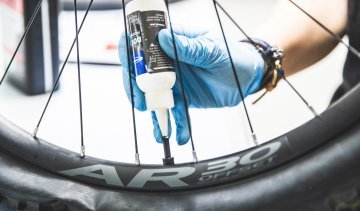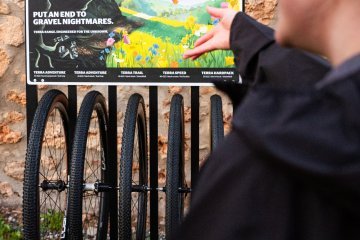
Stay tight: Tubeless Tyre Conversion
You want to convert your MTB to tubeless? In our How To Isa shows you how to get your tires tubeless and what you need for it.
The tread describes the surface of the tyre – how the knobs or grooves are shaped. It determines how your gravel tyre performs on different surfaces:
For beginners: It’s best to start with an all-round tread that gives you confidence in many situations without limiting you.

Width describes how thick your tyre is. Narrower gravel tyres (approx. 35–38 mm) roll particularly fast on asphalt and firm gravel but offer less comfort. Wider tyres (up to 50 mm) absorb bumps better, give you more grip and security on rough terrain, but are somewhat slower.
That means: Consider whether speed or comfort & control are more important to you – the right width depends on your riding style and the routes you take.
In the following table, you’ll find a clear overview of tyre widths with their advantages and disadvantages.
| Tyre Width | Application | Advantages | Disadvantages |
| 35 mm | fast & direct on hardpack & asphalt | high speed, low weight | less comfort, reduced traction |
| 38 mm | all-round: good balance for mixed conditions | versatile, easy rolling, sufficient grip | not optimal for extreme terrain |
| 40 mm | classic width for gravel & forest trails | stable, balanced between speed & comfort | slightly heavier than 35–38 mm |
| 45 mm | comfortable & safe for long tours, including bikepacking | more traction, puncture resistance, comfort | noticeably heavier, slower on asphalt |
| 50 mm | maximum grip & cushioning, mud & rough terrain | best control, high comfort, great safety | high weight, slower on firm surfaces |
Tubeless has long been standard in gravel: fewer flats, more comfort, and better traction. To make your bike tubeless-ready, you only need a few components – and some patience for the first setup.
Your choice of shoes influences how safe and efficient you are on the gravel bike. Clipless pedals connect you firmly to the bike – for maximum power transfer and control, especially on long tours or in races. Flat pedals give you more freedom, are simple for getting on and off, and are perfect for beginners or rides with walking sections.
Tyre clearance determines what maximum width your gravel bike can take. It is defined by the frame and fork and decides whether a 35 mm race tyre or a 50 mm adventure tyre fits. More clearance means more flexibility: depending on season, route, or preference, you can switch between fast, narrow setups and wide, comfortable tyres. Important: Always leave some room for mud and dirt – so your bike remains reliable even in bad weather.